The Collector | Home Tour
In the antiques-filled home of a globe-trotting Massachusetts teacher, even the upholstery has a tale to tell.
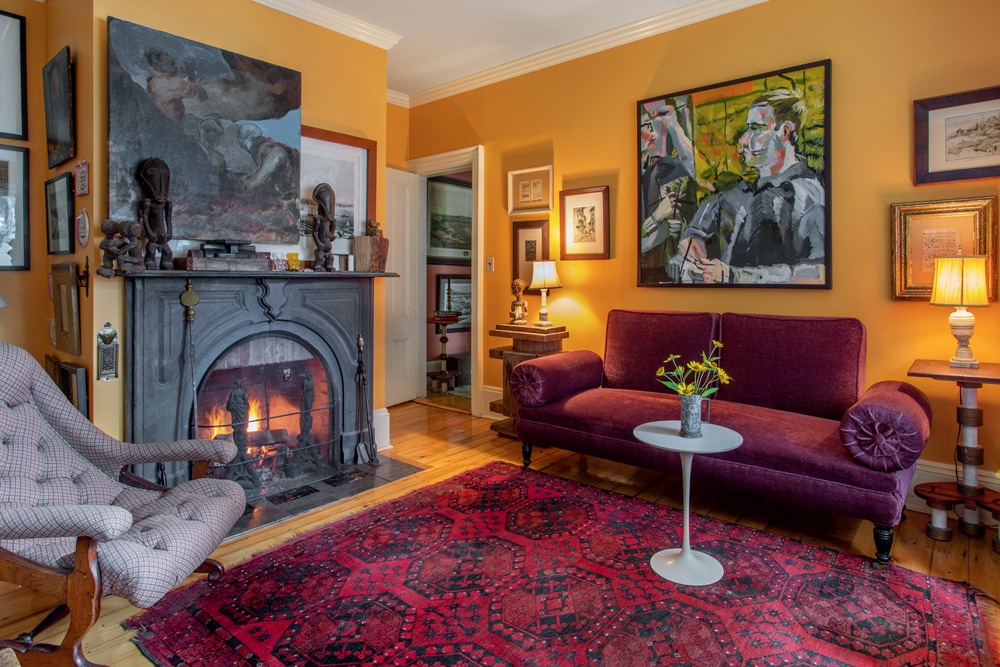
Filled with artwork and warmed by a vintage hearth, this sitting room in Louis Caldarella’s Concord home features such gems as an Eastlake sofa, a Saarinen tulip table, and a Sleepy Hollow chair that purportedly came from the White House.
Photo Credit : Eric RothLouis Caldarella’s story starts with a chair.
Specifically, a 17th-century Italian Baroque armchair spotted at an antiques shop in Cambridge, Massachusetts, where Caldarella was attending Harvard. One might think a college student in Cambridge by way of Queens might have better things to spend time, money, and energy on than a dusty piece of furniture, yet Caldarella was fixated. “I was on financial aid with three jobs, but Heidi made it happen,” he says.

Photo Credit : Eric Roth
He is referring to Cambridge-based interior designer Heidi Pribell, who Caldarella still credits 30 years later for the fearlessness of his collections. And boy, does Caldarella collect. That Italian Baroque chair, which he had upholstered in vintage Fortuny fabric procured from a curator at the Boston Athenaeum, sits in a house chock-full of antiques and vintage finds.
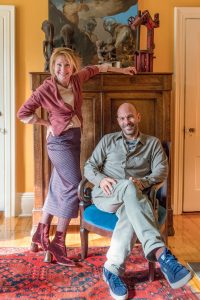
Photo Credit : Eric Roth
Jagged stone stairs punctuated by vintage pillars lead to the screen door of Caldarella’s Concord, Massachusetts, home: a 1,200-square-foot condo tucked into a clapboard house built in 1872 that was once a manse for the Trinitarian Congregational Church. Transitioning from the lush outdoor gardens is a bit of jolt, since the porch has a Spartan feel, with rickety wooden furniture, a butterfly cage made from found sycamore branches, and casual rows of no fewer than two dozen pairs of shoes.
Step fully inside and the place warms up, revealing itself as a collector’s haven. Caldarella has spent more than 20 years restoring and filling his home—once a hodgepodge of shag carpeting and other 1970s-era remnants—with furnishings collected during his travels, imbuing it with a sense of history and personal meaning. A learning specialist and tutor by profession, he is a self-described teacher, traveler, collector, and recycler to the core, and his home reflects every aspect of this persona.
In addition to working for a nearby independent school, Caldarella tutors private clients in his living room, where the tools of his trade abound. He says his students learn best with original specimens and primary sources, and that vintage materials can help relieve anxiety around learning. The relics, many picked up at flea markets in Paris (he has a recurring Parisian cat-sitting gig), are as beautiful as they are useful, such as a 19th-century brass microscope complete with slides (marine algae, eel scales, and an earwig’s head are just a few).
Every step begs a story. Neoclassical dining chairs with horsehair upholstery came from Goodspeed’s Book Shop in Boston, where Caldarella worked as the head of Americana for six years before the store was shuttered in 1995. Also acquired there was a bookcase now built into the basement staircase. The mini library includes an illuminated version of A Christmas Carol, from when he was a rare-book dealer in London, and an 18th-century illustrated folio of Aesop’s Fables.
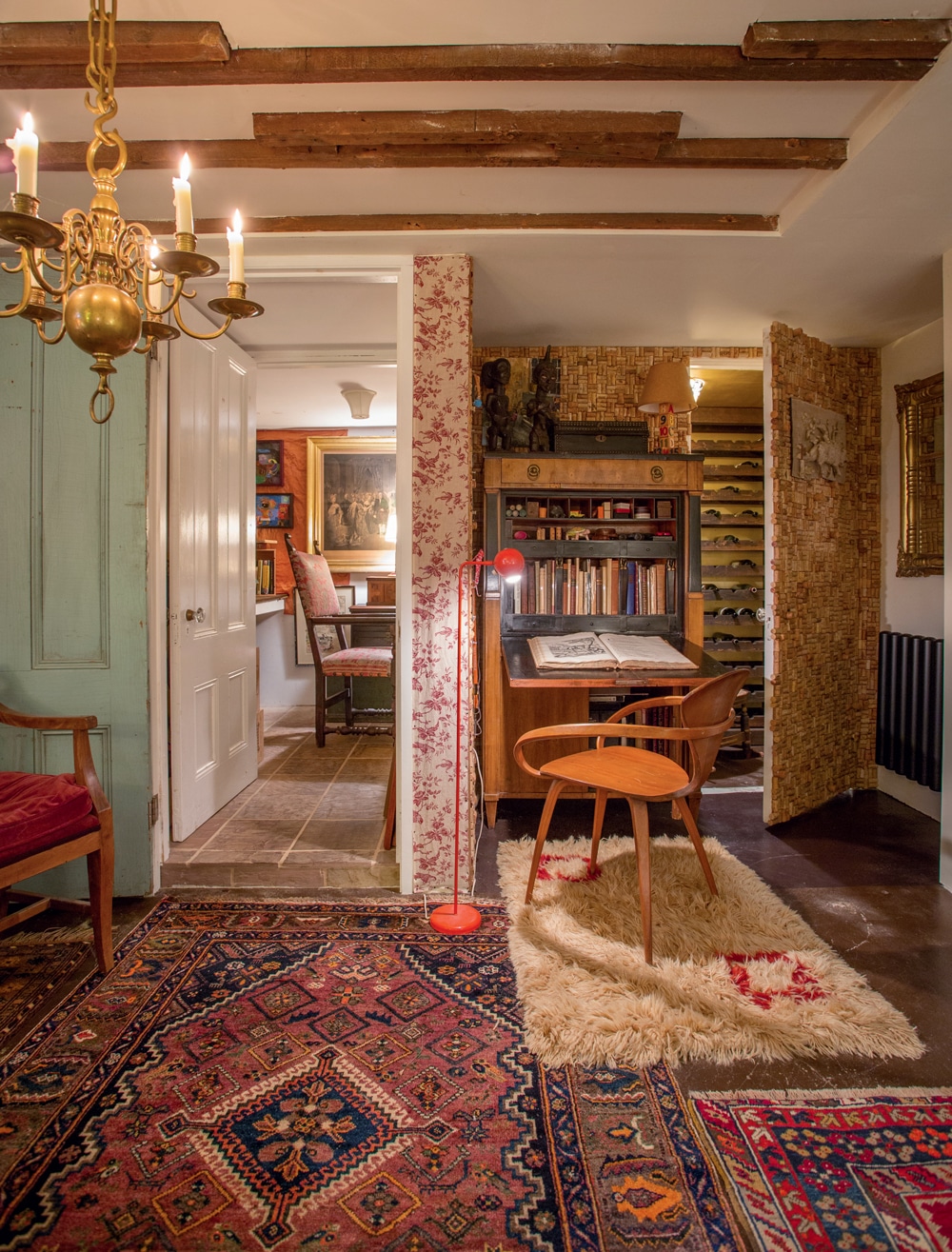
Photo Credit : Eric Roth
Caldarella’s unyielding attitude toward waste (he believes it is a sin) is evident throughout the house, from the wine closet door covered in more than 7,000 corks sent by friends all over the world, to the Adirondack chairs his father, a carpenter, made with scraps of mahogany left over from a deck they built. And rather than replace the worn floorboards in the upstairs sitting room, Caldarella pulled them up, flipped them over, and refinished them.
Pribell’s influence is also on display. The pairing of a Biedermeier secretary and a midcentury-modern Cherner armchair on the lower level is indicative of her unorthodox-yet-simpatico aesthetic. “These pieces were made almost 150 years apart, but they’re both everyman’s furniture and have complementary curves,” Caldarella says.
In his bedroom, aka the Boar Room (a bit more on that later), the peacock-green walls were inspired by endpapers of an early 19th-century French book and glazed by Pribell herself, who worked for a time as a decorative painter. “Heidi knew just how to concoct the color using a yellow undercoat, blue glaze, and brown varnish,” he says. “It’s the perfect shade of green, but contains no actual green paint!”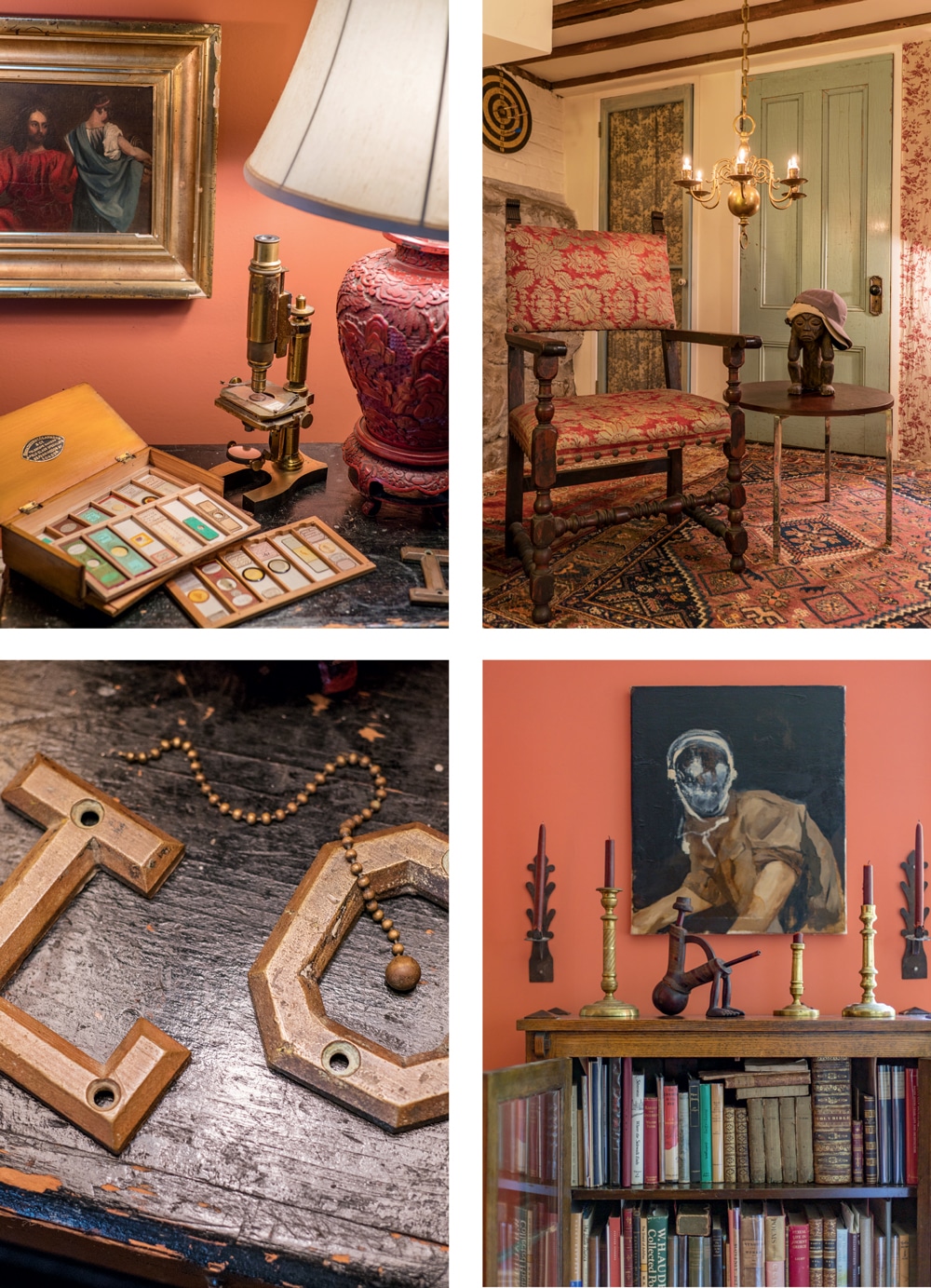
Photo Credit : Eric Roth
Even the upholstery is woven with tales. Caldarella covered the scrolled-arm neoclassical chair, found legless in Maine, with hand-dyed indigo fabric from a textile designer in Amsterdam. “I stumbled upon a house, doors wide open, fabric hanging everywhere,” he says, as though it’s a commonplace occurrence.
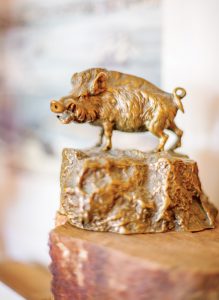
Photo Credit : Eric Roth
The bedroom showcases Caldarella’s largest collection: 50-plus images of wild boars, the symbol of the secret society he belonged to at Harvard. The first one came from a local shop, and then, he says, “the collection took on a life of its own.” He’s brought boars home from all over the world, from the stalls along the Seine, markets in Rome, and Portobello Road in London, though his favorites were gifts from and made by kids.
Caldarella keeps smaller collections in the bedroom, too, such as enamel key chains from the 1950s and a pile of Saint Christopher medals. The collections and travels, which are wholly intertwined, seem endless. Last year’s trips, which included Paris, London, New Zealand, Hong Kong, and Rwanda, have yielded antique linens, three Honoré Daumier prints bought for five euros each at the Marché d’Aligre in Paris, and some 19th-century hand-blown, acid-etched wine glasses.
Not everything, however, finds an immediate place. “I have an Ernest Roth engraving of Venice, but as I haven’t been there yet, I don’t feel I have a right to hang it,” he says. “In this case, the art comes before the travel.”
___
Sidebar: The Designer
Heidi Pribell met Louis Caldarella some 30 years ago when she was running her own antiques gallery in Cambridge, Massachusetts. Today she’s an award-winning interior designer who is known for her ability to mix styles and periods to create beautiful but livable homes. Here, she singles out three highlights of Caldarella’s home—and shares a few tips anyone can put to use.
ECLECTIC STYLE “Each doorknob, window closure, door hinge, and pull has been a vintage purchase that fits timelessly into Louis’s home. An Eastlake sofa, a Biedermeier secretary, an Italian neoclassical bed, and an American Arts and Crafts bookcase—all blend eclectically, like old friends, united by a theme: Boston 19th-century material culture.” DO:Create a narrative out of objects. DON’T: Feel obliged to stick to one time period—it’s a home, not a museum.
COLORFUL BACKDROPS “We opted for vibrant palettes throughout the home…. In the bedroom we used celery-green trim with peacock-green walls and mostly oxygen-blue ceilings throughout the home. I enjoy using apricot on the ceilings of windowless rooms, like hallways, and lavender ceilings are my favorite.” DO:Experiment using a bold wall color with contrasting trim to highlight a collection, and always use tinted contrasting color on your ceilings. DON’T:Wait to change interior finishes until you find the right piece of furniture. Often you’ll spot it later, and it will fit in seamlessly.
UTILITARIAN TREASURES “Louis uses early scientific tools and equipment to engage his students’ curiosity. All these items are easily reachable: displayed on the wall, or handy on the dining table. A Victrola phonograph with boxed vintage 78 rpm records sits nearby, always ready to play. What was once ordinary is now fresh and novel to today’s children. Everything is happily used, and things break all the time!” DO:Use the things you collect. DON’T:Keep objects stored in boxes or tucked away in the basement.


